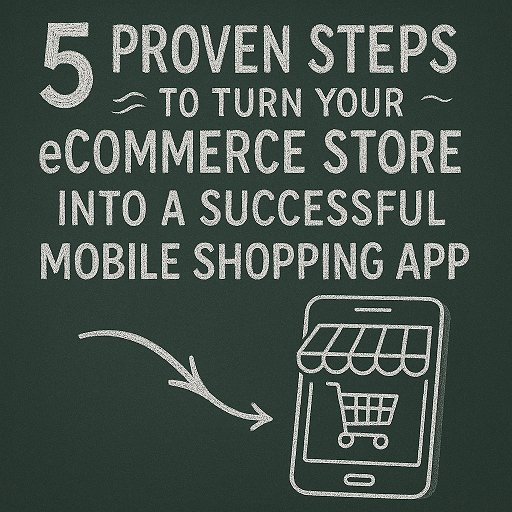In the fast-evolving world of digital commerce, having just a responsive eCommerce website is no longer enough. Consumers today expect fast, intuitive, and personalized shopping experiences right from their smartphones. If your eCommerce business is still limited to web only, you are potentially leaving a massive opportunity untapped.
That is where converting your eCommerce website into a mobile app comes in. If you are planning to convert your eCommerce store into a successful mobile application, let an eCommerce development company help you transform your website into a powerful mobile app tailored for your audience.
In this blog, we will walk you through the five essential steps to convert your eCommerce site into a mobile app, explore the rising demand, dive into real business examples, and unpack the key considerations you need to keep in mind before development begins.
Reason Behind the Rising Demand for Mobile eCommerce Apps
The numbers speak for themselves:
- Over 70% of eCommerce traffic now comes from mobile devices.
- Conversion rates on mobile apps are 3x higher compared to mobile websites.
- Users spend 7x more time in native apps than on mobile websites.
This shift is driven by how apps provide superior features like:
- Faster load times
- Personalized push notifications
- One-tap checkout experiences
- Access to saved preferences
- Offline capabilities
Apps also allow for better retention and loyalty programs, a major win in a competitive market.
Examples: Business Apps and Their Success Stories
1.) Calendly
Originally a scheduling web tool, Calendly’s leap into mobile made scheduling meetings even more seamless for on-the-go professionals. The app enhanced its accessibility, enabling users to manage appointments, send invites, and accept bookings without logging in through a browser.
Impact: Increased user engagement and retention from mobile-first professionals.
2.) H&M
H&M’s mobile app redefined convenience. With personalized feeds, real-time inventory status, visual search, and barcode scanning, the fashion brand saw a significant spike in mobile sales.
Impact: More than 60% of their online traffic now comes from mobile devices, with app users being significantly more engaged than website visitors.
3.) Nykaa:
The beauty retailer’s mobile app offers app-only sales, video content, and loyalty programs. Localized languages and personalized recommendations help in regional market penetration.
Impact: More than 90% of online sales now come from the app.
Things to Consider Before Converting Website Into a Mobile App
1.) Cost-Effective Optimization
Converting a website to an app doesn’t mean copy-pasting it into a smaller screen. Focus on optimizing core functionality. If you are working with a tight budget, prioritize MVP development – launching with only the most critical features and expanding later.
Ask:
- What are the key features our users need most?
- Can we automate or streamline certain backend processes?
2.) Choosing the Best eCommerce Features
Features make or break eCommerce apps. Some essentials include:
- User registration/login (with social login options)
- Product search & filter
- Secure payment gateway
- Push notifications
- Wishlist and cart functionality
- Order tracking
- Review & rating system
Pro tip: Personalization features like “Recommended for You” based on user behavior can significantly increase sales.
3.) Cohesive User Experience Design
The user experience must be seamless across platforms. Just because something works well on a desktop doesn’t mean it will on mobile. Design with the “thumb zone” in mind, keeping important actions within easy reach.
Also consider:
- Clear navigation with fewer taps
- Fast-loading images
- Minimal forms
- Easy checkout
Which One to Choose: Android or iOS?
Go Android if:
- Your target audience is based in Asia, Africa, or most of Europe.
- You want wider market penetration.
Go iOS if:
- Your target premium users, especially in the US, Canada, and Western Europe.
- Your average order value is higher (iOS users tend to spend more).
Or go cross-platform with frameworks like Flutter or React Native, offering native-like performance at a reduced cost and development time.
Common Challenges (And How to Solve Them)
| Challenge | Solution |
| Syncing website and app inventory | Use centralized databases or headless CMS with API sync. |
| App store rejections | Follow UI/UX guidelines strictly. Avoid beta content during initial submission. |
| Poor performance on lower-end devices | Optimize image sizes, use lazy loading, and test on budget phones. |
| Maintaining parity between app and site | Use a shared codebase or regular feature update cycles. |
| Low app adoption post-launch | Offer app-exclusive discounts, simplify onboarding, and promote across all platforms. |
Technical Architecture Overview (For Advanced Readers)
If you want to showcase your technical credibility, include this simplified architecture stack:
Frontend (App):
- Flutter / React Native
- UI Kit (Material, Cupertino, etc.)
Backend Services:
- Node.js / Laravel / Django
- REST or GraphQL APIs
Database:
- Firebase / MongoDB / MySQL
Middleware:
- Stripe / Razorpay for payments
- Firebase / OneSignal for notifications
- Sentry for crash monitoring
Hosting:
- AWS / Google Cloud / Vercel for scalability
Steps to Convert eCommerce Website into an App
Step 1: Prepare the Feature List
Start by identifying features that users frequently engage with on your website. Break this down into:
- Must-haves: User login, product catalog, cart, payment, etc.
- Nice-to-haves: Live chat, AR product reviews, loyalty programs
- Future adds: Voice search, machine learning recommendations
This step creates clarity for the development team and helps estimate the scope of work.
Step 2: Create an Intuitive UI/UX Design
Design is more than just aesthetics. It drives behavior. Here’s what to focus on:
- Streamlined homepage with personalized offers
- Easy navigation menus
- Visual hierarchy for product listings
- Consistent branding with your website
- Fast transitions and micro-interactions
Use wireframes and interactive prototypes to visualize the final experience before development begins.
Step 3: Begin the App Development Process
Choose your development approach:
- Native Development for iOS/Android for best performance
- Cross-platform for budget-friendliness and faster time-to-market
- No-code platforms (like AppMySIte or BuildFire) for simple, low-cost builds (though limited in customization)
Ensure your development team integrates:
- Secure APIs from your website
- Real-time database sync
- Payment gateways (Stripe, RazorPay, PayPal, etc.)
- Third-party plugins like analytics, chat, and reviews.
Step 4: Test Your App
Don’t launch without rigorous testing across devices, OS versions, and user conditions.
Test for:
- UI consistency
- Feature functionality
- Payment gateway performance
- Speed and responsiveness
- Security vulnerabilities
Use beta testers to identify real-world issues before going public.
Step 5: Launch Your App
Get your app approved on the Google Play Store and Apple App Store. Each store has its own guidelines for submission.
After launch:
- Promote the app via email campaigns, banners on your website, and social media.
- Offer exclusive deals for app users.
- Collect user feedback and continuously iterate with updates.
Mobile App Marketing & User Acquisition Strategies
Don’t stop at launch — grow your user base!
- App Store Optimization (ASO): Use high-search keywords in the title and description. Use appealing screenshots.
- Incentives: Give 10% off on the first in-app order. Offer “invite a friend, earn rewards” schemes.
- Push Notification Campaigns: Remind users of abandoned carts, new arrivals, and offers.
- Email + SMS Campaigns: Target existing website users to download the app.
- Retargeting Ads: Run install campaigns on Meta/Google, targeting web visitors who didn’t convert.
Wrapping Up
Converting your eCommerce website into a mobile app is not just a trend; it’s a strategic evolution. With the growing dominance of mobile commerce, businesses that offer a mobile-first experience will enjoy stronger customer loyalty, higher conversions, and sustainable growth.
Whether you are a fashion brand, a niche product seller, or a D2C startup, following the right approach and five-step process can ensure a smooth transition and a successful launch
The mobile app is no longer a luxury, it’s a necessity.
Ready to begin your eCommerce mobile app journey? Try availing mobile application development services from a renowned app development company.






